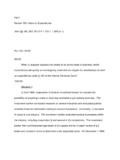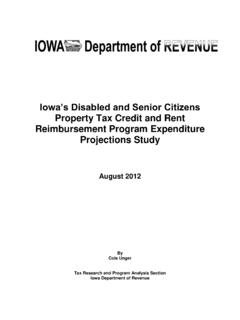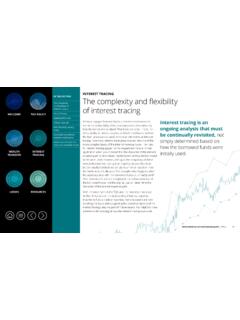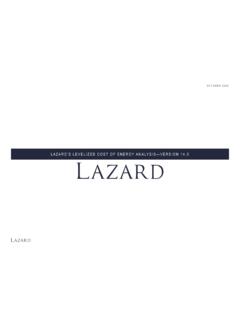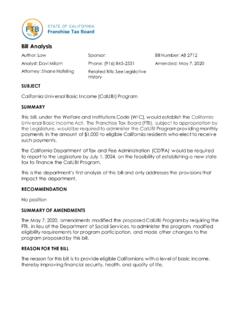Transcription of Capital v Revenue Expenditure Toolkit
1 Capital v Revenue Expenditure Toolkit 2017-18 Self-Assessment and Company Tax Returns Effective from 6 April 2018 2 Index Introduction .. 3 Areas of risk within Capital v Revenue Expenditure .. 3 Using links within this document .. 4 Checklist Capital v Revenue Expenditure .. 6 Explanation and mitigation of risks .. 9 Effective from 6 April 2018 3 Introduction Tax agents and advisers play an important role in helping their clients to get their tax returns correct. This Toolkit is aimed at helping and supporting tax agents and advisers by providing gu idance on the errors which we find commonly occur in relation to Capital v Revenue ex penditure. It may also be helpful to anyone who is completing an Income Tax Self-Assessment tax return or Company Tax return. This Toolkit should be used for financial years commencing 1 April 2017 for Company Tax returns and 6 April 2017 for Income Tax Self-Assessment tax returns.
2 Its use is entirely vo luntary. The content of this t oolkit is based on our view of how tax law should be applied. Its application to specific cases will depend on the law at the relevant time and on the precise facts. This version of the Toolkit was published in July 2018. The risks in this Toolkit have been reviewed and updated where necessary for 2017-18. For further information on using this Toolkit and reasonable care u nder our penalty system see Tax agent s toolkits. For guidance on matters not dealt with in this t oolkit you should refer to our Business Income Manual (BIM). Areas of risk within Capital v Revenue Expenditure Capital v Revenue Expenditure is a term used throughout this Toolkit . It refers to the distinction of Capital from Revenue Expenditure for tax purpos es. Expenditure that is Capital is generally not allowable as a Revenue deduction in c omputing taxable profits.
3 Depending on the nature of the Capital Expenditure it may be possible to claim c apital allowances. There is no single, simple test that can be applied to decide which items are Capital Expenditure and which are Revenue . This can only be determined by reference to the relevant facts that applied at the time the Expenditure was inc urred. In addition the classification of items as Capital or Revenue Expenditure is intrinsically linked to the particular circumstances and the exact nature of the trade. The same item may correctly be categorised as Capital in one trade, and as trading stock in anot her. This Toolkit does not reflect: The cash basis which is available from 2013-14 for the simplest small businesses. For further information see BIM70000+. Areas of risk within Capital v Revenue Expenditure fall b roadly in to the following categories: Record keeping Good record keeping is essential as poorly kept records can contribute to difficulties in identifying whether a transaction is Capital or Revenue and treated correctly for tax purposes.
4 It is therefore desirable to plan a system of record keeping that reflects the nature of Expenditure clearly. The distinction between capita l or Revenue Expenditure for tax purposes can be complex and it is therefore important to consider the records kept and the business circumstances, for example whether the business has expanded, relocated or restructured during the accounting period or even merely at tempted to do so. For further guidance on record keeping see Records for Corporation Tax. Effective from 6 April 2018 4 Acquisition, improvement a nd alteration of assets Risks relating to the allocation of Expenditure to Revenue rather than Capital will often arise from work done in the course of the purchase, refurbishment or repair of an asse t. For example business premises may be acquired or altered, or ot her fixed assets may be purchased or improved.
5 It c an be difficult to identify that apparently similar items of Expenditure should be treated differently, particularly where there are many invoices to be considered, or the exact nature o f the work carried out is not immediate ly apparent. Legal and professional fees Legal and professional fees can be incurred for a wide variety of reas ons, for example on the ac qu isition of property or other assets, or on changing the way the ownership of the business is structured. In some cases the fees will be related to Capital transactions and so will not be allowable as Revenue Expenditure . Finance costs It is important to be aware of what is included in f inance charges, and then to consider which factors may be relevant in deciding whether they are Capital or Revenue , and to what extent. Transactions relating to corporate le nding and borrowing are the subject of specific rules however, the aim of which is broadly to follow generally accepted accountancy practice ('GAAP') in recognising receipts and expenses relating to corporate debt.
6 IT costs It c an be difficult to distinguish the function that computer hardware, software and information technology perform in the business, what kind of asset they represent, o r how the costs associated with them should be handled in the accounts and tax computations. There a re a number of complexities to c onsider for Expenditure in this area. Corporate intangible assets The corporate intangible assets regime represents a significant departure from the previous rules governing the Capital or Revenue treatment of intangible assets. The regime affects assets created or acquired by companies on or af ter 1 Apri l 2002. In general, the tax rules relating to these assets follow the accounting treatment. So for example, if Expenditure on qualifying assets is written off, normally by way of amortis ation, the deduction for tax purpos es will generally follow the same approach.
7 Similarly, disposal proce eds on qualifying intangible assets would, subject to any statutory p rovi sions, follow the accepted accounting treatment . Changes to the regime made in 2014 and 2015 now mean that the tax deductions for go odwill amortis ation are more lim ited. Using links within this document Blue underlined text are links within this document. Green bold text are hyperlinks to external documents on the internet (access to the internet is necessary to view these). We have a range of services for people with disabilities, including guidance in Braille, audio and large print. Most of our forms are also available in large print. Please contact any of our helplines if you need these services. Dealing with HMRC if you have additional needs Effective from 6 April 2018 5 Giving HMRC feedback on t oolkits HMRC w ould like to hear about your experience of using the toolkits to help develop and prioritise future changes and improve ments.
8 HMRC is also interested in y our views of any recent interactions you may have had with the department. Send HMRC your feedback Effective from 6 April 2018 6 Client Name: Period Ended: Checklist for Capital v Revenue Expenditure Acquisition, improvement and alteration of assets Yes No N/A N/K 1 Has all Capital Expenditure on the purchase of assets been identified and allocated appropriately? 2 Have all items of Expenditure on the improvement or alteration of an asset been treated correctly? Has any Expenditure on essential repairs to a newly ac quired asset been treated correctly? Has any incidental Expenditure incurred when acquiring or disposing of an asset been treated correctly?
9 Legal and professional f ees Has any Expenditure on an unsuccessful attempt to obtain an asset or ot her advantage for the enduring benefit of the business been treated correctly? Has any Expenditure incurred in connection with the Capital structure of the business been treated correctly? 3 4 5 6 Effective from 6 April 2018 7 7 Legal and professional fees continued Have any costs incurred on the recruitment of additional partners to a partnership been treated correctly? Have any costs incurred on training for the proprietor or a partner in the business been treated correctly? Finance costs Where any financial payment includes a Capital element has it been treated correctly? Have all payments made by a proprietor or partnership to ac quire a franchise been treated correctly?
10 Are the arrangement fees for any long term security correctly spread over the lifetime of the security in accordance with GAAP? IT costs Has the cost of any computer software ac quired been treated correctly? Has any Expenditure incurred on website development been allocated correctly? 8 9 10 11 12 13 Effective from 6 April 2018 8 14 Corporate intangible assets Has the correct tax treatment been followed for any amortisation of goodwill acquired by a company? Has the correct tax treatment been followed for the transfer or licencing of an asset w ithin the corporate intangible assets regime either to or from a related party? General Has depreciation been added back to the accounts profit in the tax computation?










